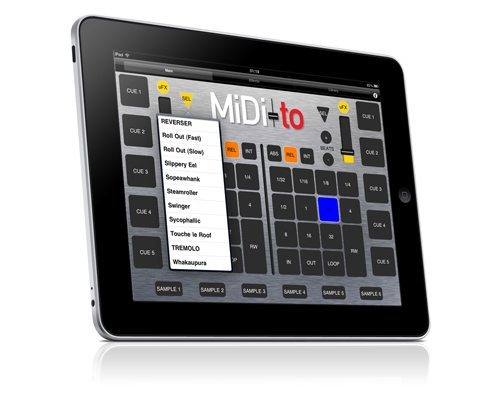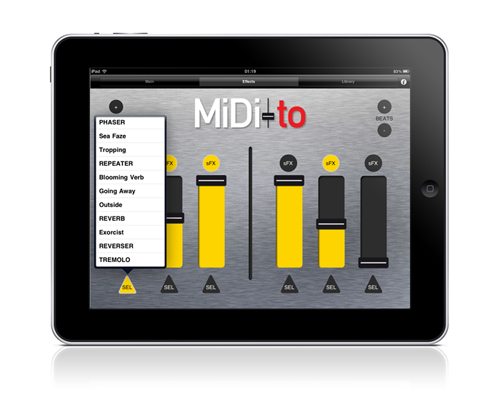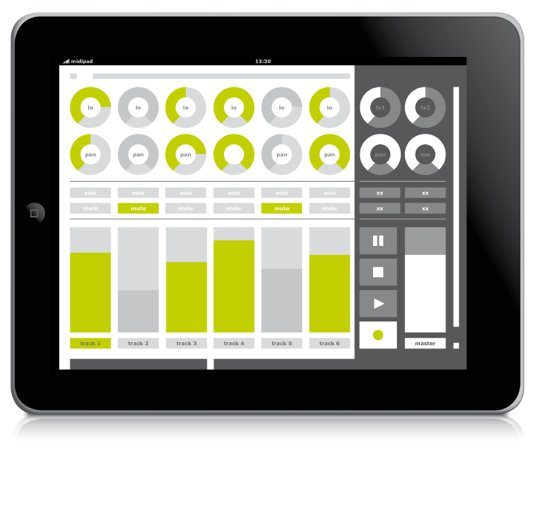Since
NAMM 2012,
IK Multimedia (better know for its guitarist-focused products) has been
promising a new range of iOS DJ software and hardware, in the form of
the iRig Mix (a slimline, portable mixer for iOS devices) and companion
app DJ Rig.
The iRig Mix is coming soon (watch out for our review), but we’ve
already had a chance to test the app. With the competitive nature of the
market for DJ apps on iPhones, how well does DJ Rig fit in – and has
the company learned from the mistakes made in some other, similar apps?
Firstly, it’s not iPad native…
From the marketing videos on
YouTube
and the welcome screen, you see the DJ Rig app running rather boldly on
two iPads either side of the iRig Mix. But when you look at the App
Store page it becomes apparent that the app has been developed
specifically with the smaller iPod screen size in mind. This is not,
then, a “universal app”.
(If you’re not familiar with that term, it means that if you want to
run it on an iPad you need to hit the “x2” button to fill the screen.
Although the functionality is all still the same, once the graphics have
been stretched to the fit a larger screen they become slightly blocked
and not as smooth as you might have hoped for. Perhaps in the future IK
Multimedia will release a “Universal” update – or perhaps an iPad-only
version.)

Twin-deck view.
The main screen shows either two decks (in landscape mode) or a single deck (in portrait).
The dual-deck view shows a familiar layout of deck A and deck B side by side with crossfader centred underneath.
The central section shows the volume levels with rotary volume
controls underneath. Again, my personal dislike of rotary dials in iOS
is gently prodded here, not only with the volume controls but also on
the EQ popup as well.
Register to unlock your EQ…
The subject of EQ brings us quickly onto the next question; should I
really have to register my email address with IK Multimedia to unlock
the EQ functionality (which is included in the initial price of the
app)? If your answer to this question is “no”, unfortunately you’re
going to be disappointed since you cannot use the EQ without registering
and activating an IK Multimedia account (via email) first.
It’s an unusual move and is likely to prove unpopular, however IK
Multimedia wants to provide better support for its products (including
apps) and would no doubt argue that enforcing registration in this way
is its method of doing so.
Should I really have to register my email address with IK Multimedia to unlock the EQ functionality?
The other controls on the main screen are fairly intuitive, although
to load a new track you need to press the “+” icon at the top left of
the deck, whereas the button which looks like an eject icon near the
bottom is to decide which function you want the button next to the
crossfader to control.
The app also offers “In-App Recording” so you can capture your mix on
the device immediately. My recommendation on this is to ensure you have
plenty of space before indulging in a two-hour set! On completion of
recording you have the option to export the file in a number of
different ways.
Instead of EQ, you could have the button set up to display a number of other options:
- Info – shows basic information about the track loaded
- Pads – displays 9 “MPC style” pads to fire one-hit samples
- FX – displays an X-Y “Kaoss Pad” style FX interface
- Loop – on-the-fly looping which can be snapped to the beatgrid
- Cue – up to 4 visual cue points can be stored per track (one as standard)
- BPM – pitch control of the deck and deck nudge control
- Wave – displays the waveform
I can understand why the development team has tried to keep the
interface as uncluttered as possible, but with the button next to the
crossfader providing access to only one function at a time it was
difficult to perform a number of different actions quickly on the same
deck.
For example, during a mix I would want to have access to the deck
nudge control – especially when tweaking the EQ, looping and applying
effects. If I had the EQ controls on the screen and suddenly needed to
nudge the deck speed slightly it would take two button presses to get to
that functionality.
The app starts to make more sense when running in single deck view,
when you have more screen space. The waveform is displayed at the top
with the six function buttons all displayed and the pitch control
positioned to the side. You can quickly switch between decks by pressing
the “A” or “B” button at the top. Personally, I preferred using the app
in the single deck mode; it was much easier to navigate around and work
with.
Along the top of the screen are a number of different icons. The “?”
icon loads the help screen where you can have a quick tutorial on how
the app works. This is done using 14 annotated overlays to the interface
and provides all the information you need to get started with the app.
The user icon requires an internet connection to register the app
(and yourself) with IK Multimedia in order to unlock the aforementioned
EQ functionality. The next icon takes you to the extensive configuration
screen where you can set all the usual detail (crossfader curve, output
mode, crossfader filter, pitch adjustment range, auto gain) but also
additional settings focused around use of the app with the iRig Mix
hardware.
The unique feature with DJ Rig is the way it uses the in-built mic to
sync the BPM of the deck to an incoming audio source. This is only
functional when used with the iRig Mix hardware and setup in the
Configuration page.
Music library access
Access to your music library is via the standard library screen. I’ve
mentioned my distaste for this method before, so I won’t repeat it here.
The search process was incredibly slow…
I would like to at least see the BPM displayed (and sortable) in the
library, which is pretty much essentail for easy DJing. Ideally I would
see the comment field as well, so harmonic mixing would be possible with
information stored in that field.
I’ve got almost 6,000 tracks on both my iPad and iPod Touch; as such
the search process was incredibly slow. It’s likely that most customers
will not have as many tracks on their device; however, I’ve found
performance for track searching on similar apps is much better.
Cue, FX and looping
A single cue point is available with the app, but this can be
extended with an in-app purchase costing US$4.99. The six FX available
as standard are high pass, band pass, low pass, delay, stutter and
phazer. The in-app purchase unlocks flanger, crush, compressor, wah,
fuzz and reverb.
The FX are beat-aligned and can be latched (or locked) on, allowing
you to do something else within the app at the same time. They have X-Y
control which we really liked.
The loop functionality feels basic when compared with other
“small-screen” DJ apps. However, you do get the ability to loop sections
of the track on the fly during playback, and these loops can be snapped
automatically to the beat grid which gets calculated when the track is
first loaded and analyzed.
Conclusion
DJ Rig had a rapid release of v1.0.1 shortly after its initial
version. This was aimed at stabilizing the app and fixing a few minor
bugs. (I did experience a few crashes with the app on both the iPad and
iPod Touch with v1.0).
The track BPM can be synced with any audio source, such as a drum machine or sequencer…
As with all DJ apps, the general advice is to close all apps running
in the background and ensure the device is in Airplane mode.
Even with these measures in place the app seemed shaky. IK Multimedia
is currently looking to address stability issues on older devices and
those with larger music libraries. Overall, then, DJ Rig certainly shows
promise; however, as a new app, there is scope for improvement.
When the iRig Mix hardware is used, the fact that the track BPM can
be synced with any audio source, such as a drum machine or sequencer or
anything else, could prove to be the winning unique feature the app
needs to stand out in the crowd. So watch out for our review of the iRig
Mix, which will help us to make our mind up about the app.






























